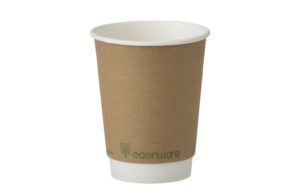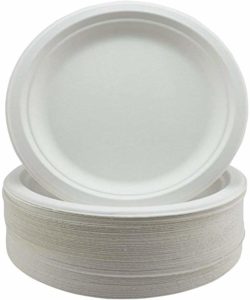
[post updated 9 Feb 2020 & 11 Mar 2020]
Bio-degradable plastic
Don’t be fooled – these are still PLASTIC! The will just break down more readily into micro-plastics, with the same detrimental effect on biology. On top of that, you CAN NOT RECYCLE bio-degradable plastic. If you add it to normal plastic for recycling, it wrecks the output. And you MUST NOT compost it, it is not harmless when it breaks down in the soil.
Many un-informed product sellers use the terms bio-degradable and compostable interchangeably, but they do not mean the same thing. Buy from someone else, don’t trust a company that doesn’t actually understand what they are selling.
About bio plastic
The most common one is Polylactic Acid (PLA) or “Corn Plastic”. Generally made from maize in the US (the same crop that might be turned into food, fed to cows or turned into bio fuels for vehicles) and hence probably genetically modified. It is also often made from tapioca or sugar cane elsewhere in the world, and other plants besides. PLA was discovered in the 1920s by Wallace Corothers (the scientist who invented nylon) but it hadn’t been successfully commercialised on a large scale previously.
Read the difference between biodegradable, compostable, and degradable. Materials that are compostable require enough heat, moisture, and certain microbes.
The pros are:
- it comes from a renewable source instead of oil, so is ‘carbon neutral’
- it is commercially compostable, and breaks down into harmless natural materials
- it doesn’t produce toxic fumes if incinerated (burning plastic is carcinogenic)
- it is ‘bio compatible’, ie suitable for medical implants that are absorbed
The cons of ‘corn plastics’ include:
- most will not break down in a home compost, only in an industrially controlled process (there are not many in the US, it is more common in the UK)
- if they look like plastic, the teams collecting your rubbish are likely to skip your bin for being contaminated. (Check if your council accepts them, and bag them in a compostable bag with printed compostable labelling.)
- it requires industrial-sized fields, competing with food crops for land
- if not composted or burnt, it will collect as rubbish in the sea, and affect wildlife the same way as plastic – it is no different from plastic in this regard
- it CAN NOT be recycled with plastics – if it gets into the plastic recycling stream, it will contaminate the load
- if it goes into landfill, it won’t have the conditions to degrade properly and will produce methane (like food does) if it degrades at all
“There has been an increase in availability of home compostable plastics. However a recent survey by Business Waste revealed that 97% of UK households DO NOT actually have a compost bin. You can read the article HERE.” [quote from 1.]
You can include small amounts of compostable starch-based ‘bio plastic’ in your kitchen waste at home. Cut it up and include it with your food waste, ideally in a compostable bag so it is not mistaken for plastic.
 Bagasse
Bagasse
Bagasse (/bəˈɡæs/ bə-GAS-se’) is the dry pulpy fibrous residue that remains after sugarcane or sorghum stalks are crushed to extract their juice. It is used as a bio-fuel for the production of heat, energy, and electricity, and in the manufacture of pulp and building materials.
This material makes plates and bowls that are tough and stiff, suitable for hot or cold , wet or greasy foods. You can use them in the microwave or freezer, or a cool oven (below 200C). They are compostable and biodegradable, much the same as paper and card. I don’t think it can be recycled.
Paper and card

Paper is biodegradable AND recyclable.
Plastic is biodegradable OR recyclable.
“Paper can degrade in any environment. Obviously paper will last for years if stored in dry conditions away from sunlight. But in the unfortunate event of paper being discarded in the open environment, buried or dropped in the sea, then it will naturally degrade and be absorbed harmlessly into the local eco-system.” [quote from 1.]
I would point out that this is also true of bagasse.
My thoughts in summary
- Always, whenever possible, go for REUSABLE rather than disposable. There is too much rubbish in the world, we don’t need to add to it.
- AVOID ALL plastic or polystyrene plates and cups, and plastic cutlery.
- Choose PAPER, BAGASSE or WOOD instead of bio-plastic
If disposable is needed, paper or bagasse is better than bio-degradable plastics, in situations where it can be used, because it will always degrade harmlessly, eventually – even in the sea. If coated, go for PLA film coated, or wax.
Put paper-based coffee cups in the black bin. They can’t go into most paper/card recycling because of the PLA film lining, as well as food contamination. If the lining is bio plastic (PLA), ask your council if they’ll take them in the composting, otherwise they have to go in the black bin. However, they will break down sooner and more harmlessly than any plastic.
Food packaging that is paper or card can be recycled IF CLEAN. If greasy or food contaminated, they go in the black bin, or tear them up and add them to your HOME compost.
Bio plastics will cause the same problems in landfill as ordinary plastics, so best avoid altogether.
NEVER mix the two kinds of plastic, there is no way for the processors to tell them apart either visually or mechanically, and a whole load could end up in landfill/incineration rather than risk processing a mixed load. So it’s best to put drinks in paper cups, to avoid this confusion.
Compostable food waste bags are a logical route for food waste being composted. You can also line your caddy with newspaper (or bought paper liners), which can be readily composted by the council or at home. Be aware, not all councils who process food waste allow the use of compostable bags, so follow the local guidance. Bio plastic does have issues with other uses, like the new trend for biodegradable carrier bags. In a landfill environment, they can produce methane, but if incinerated (as many councils do) they are better normal plastic.
Plastic cutlery is NOT recyclable kerbside nor Terracycle, even if clean. It will be discontinued eventually. The tougher ones can be reused extensively so if you’ve got some please collect it up again for washing. Wooden cutlery is gaining in popularity. It can’t be reused, but be sure to collect it up to go into the garden waste collection. It is also better than plastic for either landfill or incineration.
Wherever possible, avoid disposable things which are a waste of our limited resources. And if unavoidable, choose paper-based (or bagasse) or wood-based options especially if they will end up in the bin anyway.
Some of my sources:
- Which is more eco-friendly…paper, or biodegradable plastic?
- Are biodegradable plastics eco-friendly?
- Microplastics in the Environment – discusses the source of microplastics, the effects they have on living things, and potential solutions.
- The Environmental Impact of Corn-Based Plastics
How does corn-based plastic stand up against its petroleum based counterpart? - The Pros and Cons of Polylactic Acid (PLA) Bioplastic, the “Corn Plastics”
- Pros and Cons of PLA: Corn-Based Plastic
- The Difference Between Biodegradable, Degradable and Compostable
Includes Zero Waste tips for commercial kitchens - Teabags: Is there plastic in yours?
This BBC article considers bio plastic to be still basically plastic - Polylactic acid or polylactide (PLA)
